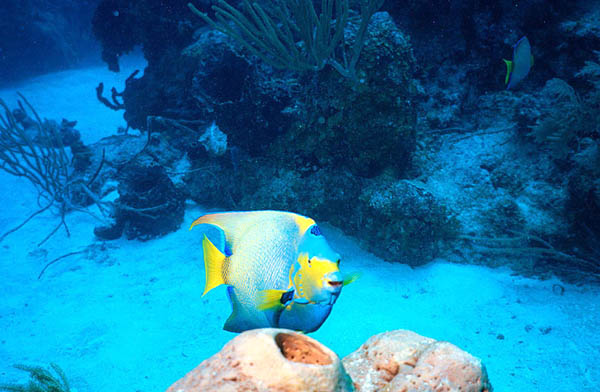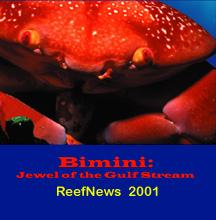

Why are these beautiful fish so difficult to photograph? Queen Angelfish are among the most beautiful of Atlantic reef fishes. This Queen Angelfish was swimming near the reef at a depth of 70 feet. Its bright yellow fins and scales make a vibrant pattern against its light blue body. Notice its yellow face and the blue highlights on its eyes and mouth. Also notice the blue circle on the top of its head, the "crown" that gives this fish its name. Queen Angelfish are very shy, even more shy than French Angelfish, making them very difficult to approach with a camera.
Queen Angelfish are found throughout the Caribbean but are seen only occassionally. Like other Angelfishes and Butterflyfishes, Queen Angelfish have tall, narrow bodies. Because they are so thin, they can turn quickly and can maneuver down into narrow cracks between the corals to hunt their prey. They swim by rowing with their pectoral fins. Their long dorsal, anal, and caudal (tail) fins allow them to turn quickly. This adult Queen Angelfish was about 12 inches long.
Also notice the many colorful Sponges on the reef surrounding this Queen Angelfish. Sponges are colonies of thousands of tiny invertebrate animals. The bright orange sponge at the bottom is an Orange Encrusting Sponge. More "excurrent pores" on another Orange Encrusting Sponge are visible just in front of the Angelfish. Underneath the Angelfish is a small brown Barrel Sponge. The small round brown sponge just above the Angelfish is a thick-walled tube sponge that we call a Volleyball Sponge. Sponges eat by pumping water. Read all about that on the ReefNews Yellow Tube Sponge website. The reef also is covered by hundreds of tiny green leaves of several different kinds of Algae, some of the few kinds of plants found on tropical reefs. The presence of so many sponges and algae are signs that this coral reef is not healthy. On a healthy reef there would be many living corals covering this coralhead.
Tessa Dowell took these pictures at a reef called Little Caverns near the west coast of Bimini in June, 1999. She used a Nikonos V camera with a 28 mm lens and SB105 strobe. Little Caverns gets its name from the many holes and tunnels in the coral heads, which make excellent places for all kinds of marine creatures to hide.

This picture shows another view of the Queen Angelfish. Notice that it has a slender body. From the front, you can see both of its eyes, indicating that this Angelfish is capable of seeing with binocular vision. In the distance you can notice the slender profile of its mate swimming away from us. Look for its bright yellow tail against the coral head in the distance, above and to the right of the Queen Angelfish in the foreground. Like many other Angelfishes and Butterflyfishes, Queen Angelfish mate for life and are often found swimming in pairs.
See another angelfish at Little Caverns Reef, the French Angelfish.
See a much larger Brown Barrel Sponge on the Rock Beauty Angelfish webpage.
 Learn more about the Coral Reefs of Bimini on the 2001 ReefNews CD-ROM
Learn more about the Coral Reefs of Bimini on the 2001 ReefNews CD-ROM
Bimini: Jewel of the Gulf Stream